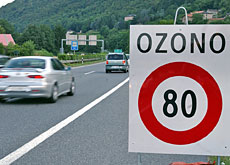
Speed limits fail to reduce ozone levels

The use of measures such as speed limits to keep ozone levels low during summer has little effect, Swiss scientists say. Most of the toxic gas comes from abroad.
According to the latest research, there is no correlation between speed and the presence of ozone in the air.
Ticino and Graubünden were the first cantons to introduce speed limits on certain stretches of motorway in August 2003 as Europe suffered from an unprecedented heatwave, which in Switzerland caused almost 1,000 additional deaths.
At that time, they decided to lower the maximum speed limit from 120 km/h to 80km/h.
Studies carried out by the Paul Scherrer Institute (PSI), Switzerland’s largest national research centre, found that the reduction in pollution that resulted from such limits was negligible.
“According to our simulations, the introduction of a national speed limit of 80km/h would result in a reduction of ozone concentration in the air to one per cent at the most,” said André Prévôt from the institute’s atmospheric chemistry lab.
Like other toxic substances, ozone enters Switzerland from across its borders. Due to strong thermal currents, the gas rises into the atmosphere and then falls on the earth, often thousands of kilometres away from its source.
According to the PSI, 75 per cent of the ozone present in German-speaking Switzerland comes from other countries.
“Most comes from Europe and it seems that a not insignificant percentage comes from Asia and the United States,” Prévôt said.
Ticino
South of the Alps and in particular in Ticino the situation is difficult, given the region’s proximity to Italy.
“More than 50 per cent of the ozone measured south of the Alps comes from the neighbouring Italian region of Lombardy, which renders Swiss speed limits useless,” Prévôt said.
These findings are a source of concern for Luca Colombo from Ticino’s cantonal office for air protection but he supports the use of speed limits.
“Limiting speed to 80km/h enabled us to reduce ozone emissions substantially in our canton, sometimes by up to half. It isn’t just ozone; there are other noxious substances, like fine particles, which can also be fought by such measures,” Colombo said.
For his part, Prévôt stressed that the research results had to be seen in a certain context.
“The data we presented was… from computer simulations,” he said. “They should be viewed with care.”
Gothenburg Protocol
Albrecht Neftel from the Agroscope federal research station says the authorities ought to adopt appropriate measures before the alarm level is reached, and in accordance with scientific data.
“Local and isolated intervention has little effect,” he said.
Switzerland is one of many countries counting on the 1999 Gothenburg Protocol to abate acidification, eutrophication and ground-level ozone.
The protocol set emission ceilings for 2010 for four pollutants: sulphur, nitrogen oxide, Volatile organic compounds (VOCs) and ammonia. Once the protocol is fully implemented, Europe’s sulphur emissions should be cut by at least 63 per cent, its nitrogen oxide emissions by 41 per cent, its VOC emissions by 40 per cent and its ammonia emissions by 17 per cent compared with 1990.
“The problem is not only ozone but also the precursors of this gas, such as nitrogen, or fine dust particles which contribute to what is called summer smog,” said Stefan Füglister, a campaigner for the transport and environment association.
swissinfo, based on an Italian article by Luigi Jorio
The limit value for ozone is 120 micrograms per cubic metre.
In July the record was exceeded many times in the mountains of Switzerland as well as in the plains.
Ozone value peaks recorded in July.
Lugano (city, canton Ticino): 270 micrograms per cubic metre (July 27).
Magadino (countryside, canton Ticino): 232.
Basel (built-up area): 184.
Jungfrau (mountain in canton Bern): 141.
“Bad” ozone
Ozone is found in the troposphere, which is the lowest region of the atmosphere, extending from the earth’s surface to a height of about 6-10km.
Ozone is not generated directly by human activity, but forms as a result of prolonged exposure to the sun, first of all from nitric oxide and volatile organic compounds (VOC).
The main cause of nitric oxide emission is motorized traffic, whereas industry and households generate VOC.
The effects on humans include irritation of the mucous membranes, inflammation of the respiratory tract, reduction of the lungs’ function and physical performance.
“Good” ozone
Stratospheric ozone is found in the higher regions of the atmosphere and protects us from ultraviolet rays.
Over the past few years, this type of ozone has been reduced considerably (the famous ozone hole), owing to an excessive use of substances such as chlorofluorocarbon (CFC).

In compliance with the JTI standards
More: SWI swissinfo.ch certified by the Journalism Trust Initiative
















![The four-metre-long painting "Sonntag der Bergbauern" [Sunday of the Mountain Farmers, 1923-24/26] had to be removed by a crane from the German Chancellery in Berlin for the exhibition in Bern.](https://www.swissinfo.ch/content/wp-content/uploads/sites/13/2025/12/01_Pressebild_KirchnerxKirchner.jpg?ver=cb688ed5)















You can find an overview of ongoing debates with our journalists here . Please join us!
If you want to start a conversation about a topic raised in this article or want to report factual errors, email us at english@swissinfo.ch.